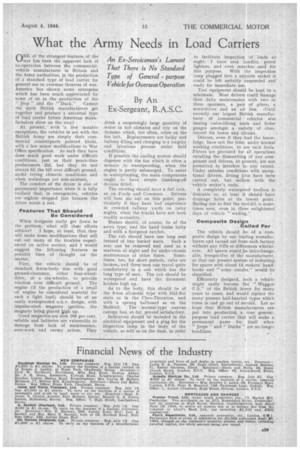What the Army Needs in Load Carriers
Page 31

If you've noticed an error in this article please click here to report it so we can fix it.
An Ex-Serviceman's Lament That There is No Standard Type of General purpose Vehicle for Overseas Operation
By An Ex-Sergeant, R.A.S.C.
ONE of the strangest' features of the war has been the apparent lack of co-operation between the commercialvehicle manufacturer in Britain and the Army authorities, in the production of a standard type of load carrier for general use in overseas theatres of war. America has shown some enterprise which has been much appreciated by some of us in the production of the "Jeep " and the " Duck." Cannot the main British manufacturers get together and produce a universal type of load carrier before American manufacturers show us the way?
At present, with a few notable exceptions; the vehicles ip use with the British Army are simply their commercial counterparts painted khaki, with a few minor modifications to War Office specification. As such they have done much good work under difficult conditions, just as their peace-time predecessors did, but they do not always fill the bill over difficult ground, under trying climatic conditions and when workshops are non-existent.
The comfort of the driver is also of paramount importance when it is fully realized that, in emergencies, vehicles are seldom stopped just because the driver needs a rest.
Features That Should Be Considered When designers really get down to the problem, what will their efforts achieve? I hope, at least, that they will make some modifications that will cut out many of the troubles experi• enced on active service, and I would suggest the following features as possible lines of thought on the matter.
First, the vehicle should be of standard 3-ton-body size with good ground-clearance, either four-wheeldrive, or a six-wheeler, to provide traction over difficult ground, The engine (if the production of a small oil engine be considered wasteful for such a light load) should be of an easily waterproofed o.h.v. design, with impulse-start magneto ignition, the magneto being placed lligh up.
Good magnetos are now 100 per cent. reliable and batteries are vulnerable to damage from lack of maintenance, over-work and enemy action. They drink a surprisingly large quantity of water in hot climates and rely on the dynamo which, too often, relies on the fan belt. Replacements are bulky and battery filling and charging is a lengthy and laborious process under field conditions.
If possible the cooling system should dispense with the fan which is often a menace .to waterproofing, when the engine is partly submerged. To assist in waterproofing, the main components ought to have simple blanking-off devices fitted.
The steering should have a full lock, as on Fords and Commers. Drivers will bear me Out on this point, particularly if they have had experience in crowded railway yards on rainy nights, when the trucks have not been readily accessible.
Brakes should, of course, be of the servo type, and the hand brake hefty and with a foolproof ratchet.
The cab should have one long seat
instead of two bucket seats. Such a seat can be removed and used as a mattress at night and for under-chassis maintenance at other times. Sometimes, too, for short periods, rules are broken, and three men can travel quite comfortably in a cab which has the long type of seat. The cab should be waterproof and have the document holders high up.
As to the body, this should be of the 3-ton all-metal type with fold-flat seats as in the Chev-Thornton, and with a sprung tailboard as on the Bedford. The normal-type canvas canopy has, so far, proved satisfactory.
Indicators should be included in the electrical equipment and a plug for the inspection lamp in the body of the vehicle, as well as on the dash, in order to facilitate inspection of loads at night. I have seen candles, petrol lighters, and even matches used for this purpose. With the inspection lamp plugged into a suitable socket it could be left suitably suspended and ready for immediate use.
Tool equipment should be kept to a minimum. Most drivers could manage their daily maintenance with two or three spanners, a pair of pliers, a screwdriver and an air line. -Until recently oar largest British manufacturer of commercial vehicles was issuing valve-lifting tools and feeler gauges amongst a variety of obso lescent tin boxes and oilcans. • Drivers, evert if they had the knowledge, have not the time, under normal working conditions, to use such tools. Fitters are provided for all operations entailing the dismantling of any component and drivers, at present, are not permitted to interfere to any extent. Under extreme conditions with exceptional drivers, fitting jobs have been carried out, hut seldom with the vehicle maker's tools.
A completely waterproof toolbox is desirable or, at !east it should have drainage holes at its lowest point. Bailing out to find the tool-kit is sometimes seen, even in these enlightened days of vehicle " wading."
Composite Design Called For The vehicle should be of a composite design by our leading manufacturers and turned out from each factory without any frills or differences whatsoever. All spares would be interchangeable, irrespective of the manufacturer, so that our present system of indenting for spares with about 15 makers' handbooks and " army vocabs." would be simplified.
Efficiently designed, such a vehicle might easily become the "Waggon CS." of the British Army for many years to come, 6.nd would replace the many present half-hearted types which tome in and go out of service. Let us hope that British manufacturers can put into production a true generalpurpose load carrier that will make a permanent name for itself when " Jeeps " and " Ducks " are no longer headlines.




















































